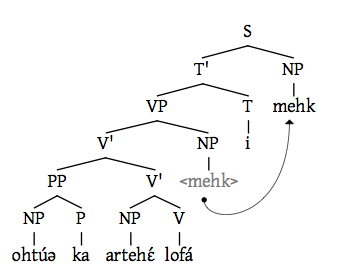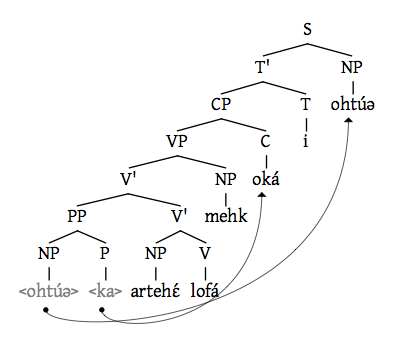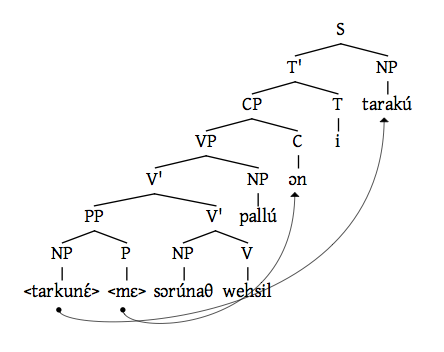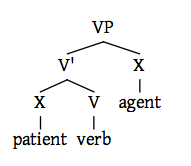Re: Telpahké: the thread - Transitivity and voice assignment
Posted: Sat Jan 26, 2019 12:53 pm
Teeny-tiny question: how do you keep changing the thread name to reflect the most recent update? What's the function for it?
Crossing our fingers
https://verduria.org/


Yes! TreeForm is awesome, literally helped me get a first in my syntax modules at Uni.akam chinjir wrote: ↑Mon Mar 11, 2019 1:15 pm First, quickly---are you using TreeForm for the diagrams? And what's CP in this context?
What you’re saying makes sense to me, but I’m writing this on my phone and hence no TreeForm. I’ll be honest, I’m not married to Minimalism or X’ and I haven’t thought extensively about the "deep structure" (note the lack of vP shells etc!) as it were. I’ll reply in more detail when I get home.Second, maybe a bit more involved. Am I right to think that in a patient voice clause, the patient would end up in the same spot as the agent does in the first tree and the oblique does in the second one? That looks like Spec-TP, which you'd normally think of as the place where the subject goes. Which is to say---this really does look more like a voice alternation than like topicalisation, sort of like an applicative but with the applied argument somehow raising to subject. Does that sound at all right to you?


(This is more or less exactly why I asked, I was hoping for something that shows movement a bit better and with a bit more flexibility)
I'm actually in the process of trying to understand this and related stuff, which maybe is a way of being married to it.dewrad wrote: ↑Mon Mar 11, 2019 1:42 pm What you’re saying makes sense to me, but I’m writing this on my phone and hence no TreeForm. I’ll be honest, I’m not married to Minimalism or X’ and I haven’t thought extensively about the "deep structure" (note the lack of vP shells etc!) as it were. I’ll reply in more detail when I get home.
So I was looking back - incidentally thank you for my latest fix, I was getting withdrawal symptoms - in the above sentence, the woman (the agent) is ablative. I presume the man here is in the absolutive case. So, assuming I have parsed that correctly what happens if we put the sentence into the patient voice? Outside of the benefactive, the woman (selé) would be ergative and the fish (mɛsar) in the absolutive, but if we use the benefactive then on the basis of what you're saying now I'm not clear on whether I would use rɛ or ɔr to mark the woman agent and how that shifts the word order around.Selé rɛ masrɛ́ pɔkahtá i túǝn.
siǝl-é rɛ mɛsar-ɛ́ pɔk-aht-á i túǝn
woman-ACC ABL fish-ACC cook-BEN-AV AUX man
"A woman cooks a fish for the man."
| agent voice | patient voice | |
| perfective | rak-á | rak-íl |
| imperfective | rah-tá | rak-ó |
| agent voice | patient voice | |
| perfective | tehł-á | tehł-íl |
| imperfective | tehł-itá | tehł-ó |
I will admit that it's the only thing that really bugs me about the program.akam chinjir wrote: ↑Tue Mar 12, 2019 12:54 am(This is more or less exactly why I asked, I was hoping for something that shows movement a bit better and with a bit more flexibility)
Thank you for your thoughts, they are greatly appreciated! However, if you don't mind, I am going to park a response for now: I want to get the whole of the verb system on paper first and then go back and start attempting to analyse the syntactic structures in depth (for one thing, I need to find/dust off my textbooks to refresh my memory on a course that was quite a few years ago now...)akam chinjir wrote: ↑Tue Mar 12, 2019 12:54 amI'm actually in the process of trying to understand this and related stuff, which maybe is a way of being married to it.
Here are some things that stand out for me in your diagrams.
If I understand your question correctly, do you mean how would the sentence look if the woman were the topic rather than the man? If so, the answer is as follows:evmdbm wrote: ↑Tue Mar 12, 2019 8:05 amSo I was looking back - incidentally thank you for my latest fix, I was getting withdrawal symptoms - in the above sentence, the woman (the agent) is ablative. I presume the man here is in the absolutive case. So, assuming I have parsed that correctly what happens if we put the sentence into the patient voice? Outside of the benefactive, the woman (selé) would be ergative and the fish (mɛsar) in the absolutive, but if we use the benefactive then on the basis of what you're saying now I'm not clear on whether I would use rɛ or ɔr to mark the woman agent and how that shifts the word order around.Selé rɛ masrɛ́ pɔkahtá i túǝn.
siǝl-é rɛ mɛsar-ɛ́ pɔk-aht-á i túǝn
woman-ACC ABL fish-ACC cook-BEN-AV AUX man
"A woman cooks a fish for the man."
Of course! Meanwhile I'll be puzzling out how to make syntactic sense of some of my own ideas (no promises of actual diagrams any time soon, though).dewrad wrote: ↑Sat Mar 16, 2019 9:18 am Thank you for your thoughts, they are greatly appreciated! However, if you don't mind, I am going to park a response for now: I want to get the whole of the verb system on paper first and then go back and start attempting to analyse the syntactic structures in depth (for one thing, I need to find/dust off my textbooks to refresh my memory on a course that was quite a few years ago now...)
If I understand your question correctly, do you mean how would the sentence look if the woman were the topic rather than the man? If so, the answer is as follows:
Masrɛ́ pɔkahtá túǝn ɔr i síǝl.
mɛsar-ɛ́ pɔk-aht-á túǝn-Ø ɔr i síǝl-Ø
fish-ACC cook-BEN-AV man-ABS PTC AUX woman-ABS
"The woman cooks a fish for a man."
I’m glad you remember Telpahké fondly!
This is a very unusual sequence, especially with /φ/fricatives: /φ θ s h/ f θ s h